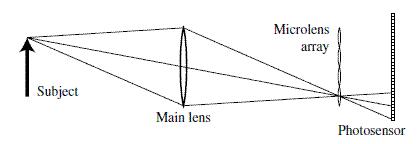| Light field camera - shoot first, focus later |
| Written by David Conrad |
| Thursday, 23 June 2011 |
|
Photography has more or less gone 100% digital but does it make maximum use of the new technology? In theory it would be best to use a digital sensor that recorded the light field at the moment the camera was taken and then reproduced that light field when the picture was viewed. This is, of course, what a hologram does, but creating a digital hologram camera and projector is a tough job. However, there are other more subtle and more practical solutions to the problem. A new silicon valley startup Lytro has taken some research done at Stanford and created a practical light field camera. You can't buy one just yet but you can put your name down to have an option to buy one in the very near future. Why would you want a light field camera? There are a number of possible answers but at the moment only one is on offer. You can take a light field photograph and, using reconstruction algorithms, present it so that the focus is anywhere you care to select. That is, you can take a photo without focusing and then set the focus using software - i.e. shoot first, focus later. Lytro is calling its refocusable photos "living photos" because the viewer can interact with them. At the moment the reconstruction software runs in Flash and so you can only view the photos via a browser that supports Flash - sorry iPad/iPhone users. You can see an example below. Just click on any part and you will see it automatically focus on that point. If you double click then it will also zoom.
Notice that this approach does have its disadvantages in that you can't view the picture in a dumb photoframe for example. However with a little more software things start to get very interesting. A digital darkroom addin could be created that let you set the focal plane and convert to a more standard "non-living" format (JPEG say). More exciting is the prospect of software that renders the image as in-focus across its entire area. This would remove the age old laws of aperture and depth of field. Of course some photographers might say that this would take away the fun and much that is artistic. After all do you really want photos that are in sharp focus from closeup to infinity? Of course, the after market in apps that puts back the classic depth-of-field look into an arbitary light field photo would once again add fun and art! If you want to see the sort of thing it might be useful for take a look at the video: Going even beyond the perfect focus, the information captured by the camera permits a 3D reconstruction of the image. Yes, a 3D camera with a single lens! This last observation is in fact untrue because the light field camera has lots and lots of lenses - this is the basic principle of its operation. A standard photographic lense is used to form an image in the usual way but then a micro-lens array is used to capture lots of smaller images on a high resolution sensor. This is called a plenoptic camera.
The result of taking a photo with a plenoptic camera is a lot like the arty photos you see where a set of images are used as the pixels for a bigger photo. That is if you look at the output of the light field camera what you see is what looks like a grainy photo of the entire scene - but when you focus in on the pixels that make up the image you start to see that each one is an image formed by one of the micro-lenses. Each of the tiny images contains information from a particular point of view and this can be used together with the total image data to reconstruct a photo that is in focus for that point of view.
Of course there are tradeoffs. You are recording a lot of information using a high resolution sensor but a lot of this information isn't used in reconstructing any particular viewpoint - that is you would get a better quality picture if you used the sensor without the micro lens array in a conventional camera. This shouldn't be a problem as long as sensor resolutions keep going up. So do you want a light field camera? A lot depends on the software that follows. The only real advantage of taking a focus-free photo is that it can be fast as you don't need to wait the time it takes for the autofocus to work. Living photos are something of a talking point at the moment but this one novelty isn't enough to make the technique worth adopting. Now give us the option of complete focus, 3D and shifting point of view and it might be a big hit. Notice that it all comes down to the reconstruction algorithms... More InformationIf you would like to be informed about new articles on I Programmer you can either follow us on Twitter or Facebook or you can subscribe to our weekly newsletter.
|
| Last Updated ( Thursday, 23 June 2011 ) |


